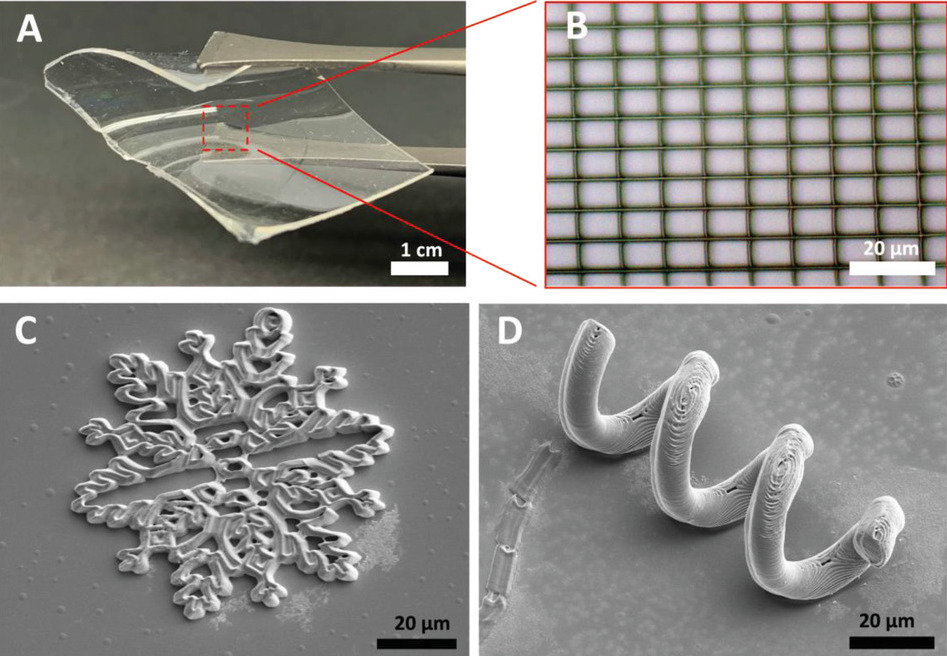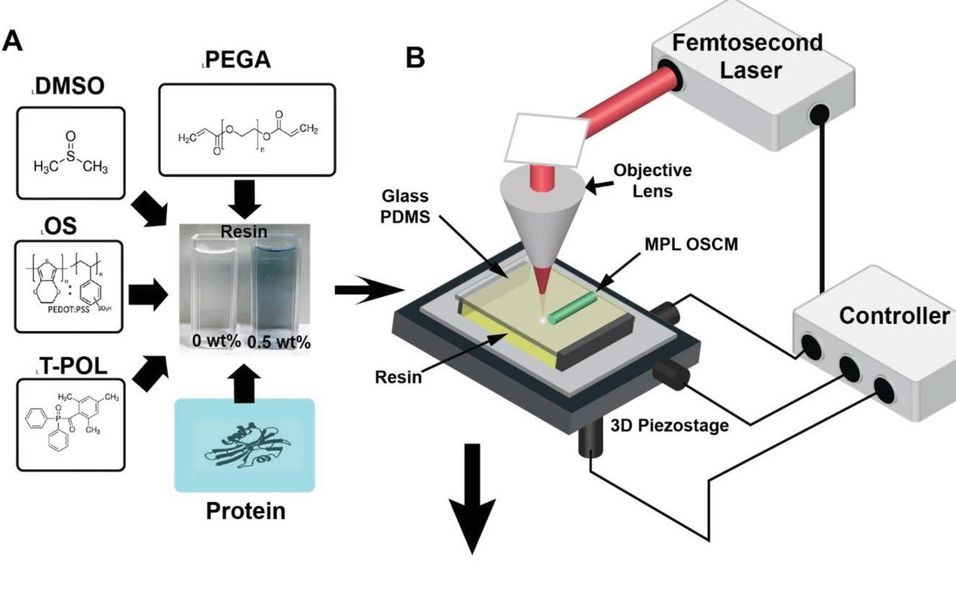Scientists at the University of Houston have developed a novel method of 3D printing bio-sensors that could one day be implanted into human hosts.
Using multiphoton lithography (MPL), the team’s approach involves polymerizing a resin loaded with an organic semiconductor material layer-by-layer, to form tiny, biocompatible circuit boards. Thus far, the researchers have utilized their process to create highly-accurate glucose sensors, but with further R&D, they believe it could pave the way for the production of a new generation of bio-electronic devices.
“Here, a homogenous and transparent photosensitive resin doped with an organic semiconductor (OS) material is introduced to fabricate a variety of 3D OS composite microstructures (OSCM),” say the team in their paper. “[Our] results demonstrate the great potential of these devices for a wide range of applications from flexible bioelectronics, to nanoelectronics and organ-on-a-chip devices.”

Bringing conductive implants to life
In their paper, the researchers identify MPL as the “state-of-the-art” in Direct Laser Writing (DLW) 3D printing, due to its material versatility and the high level of accuracy it’s able to achieve (down to a resolution of 15 nm). As such, the Houston team sees the technology as ideal for producing the types of nano-electronic devices that have become the subject of intensive research over the last few years.
However, the viability of 3D printing such bio-implants continues to be limited by the low conductivity of the materials used to produce them. According to the scientists, this is due to the fact that prototype bio-electronics are often made from carbon nanotubes or graphene, so they have inorganic properties that are “difficult to disperse homogeneously” in resins “without significant phase separation.”
To get around these drawbacks, the Houston researchers have therefore developed an MPL resin of their own, composed of a PEGA polymer loaded with DMSO, a PEDOT:PSS organic semiconductor, laminin and glucose oxidase, that can be precisely 3D printed into mini bio-circuit boards with homogeneous properties.

3D printing cytocompatible PCBs
Initially, the researchers used their material to produce multiple microelectronic devices, including a printed circuit board (PCB), featuring an array of micro capacitors. Once they’d demonstrated the efficacy of their technique, the team began experimenting with laminin, a glycoprotein found in the membranes of different animal tissues, that facilitates cell attachment, signaling and migration.
Having loaded their resin with proteins, the team went on to 3D print it into further complex microstructures, before culturing these inside mouse tissues for 48 hours. Compared to non-dosed samples, the scientists noted that their cells showed evidence of “enhanced survival,” while also retaining the ability to facilitate both attachment and proliferation.
After establishing the biocompatibility of their implants, the researchers sought to assess the devices’ electrochemical properties. Testing at the biologically-relevant frequency of 1 kHz showed that the electrical impedance of the team’s PCBs decreased across all frequencies (1 to 105 Hz) as the diameter of microelectrodes increased, results that were ‘in agreement with those reported previously.’
Lastly, to showcase the potential applications of their approach, the scientists used it to produce a novel bio-sensor that was capable of deploying electric currents to detect glucose levels with high stability and precision. Given that this device featured a ten times higher sensitivity than current monitors, the team say their resin could now help accelerate humanity’s progress towards cybernetic implants.
“We anticipate that the presented MPL-compatible OS composite resins will pave the path toward production of soft, bioactive, and conductive microstructures for various applications in the emerging fields of flexible bioelectronics/biosensors, nanoelectronics, organ-on-chips and immune cell therapies,” concluded the researchers in their paper.

Pushing the envelope with cybernetics
As sci-fi as the idea of cybernetic implants may sound, the Houston team’s project isn’t the first to use 3D printing as a means of getting closer to realizing them. In the past, Renishaw has carried out a study alongside Herantis Pharma, which saw it 3D print a neuroinfuse drug delivery device, designed to treat Parkinson’s disease.
Similarly, scientists at the University of Sheffield, St Petersburg State University and Technische Universität Dresden have previously developed a 3D printed neural implant for treating nervous system injuries. Theoretically at least, the device combines biology and electronics in a way that allows the brain to be linked to a computer, thus empowering doctors to address neurological conditions.
Likewise, in another experimental use case, Joshua Uzarski of the CCDC Soldier Center told 3D Printing Industry last year that the US Army is currently working on Cyberpunk-style bio-sensors. The devices, which remain at a very early stage of development, could be used to physiologically track troops, while also providing them with an enhanced awareness of potential situational threats in the field.
The researchers’ findings are detailed in their paper titled “Multiphoton Lithography of Organic Semiconductor Devices for 3D Printing of Flexible Electronic Circuits, Biosensors, and Bioelectronics.” The study was co-authored by Omid Dadras-Toussi, Milad Khorrami, Anto Sam Crosslee Louis Sam Titus, Sheereen Majd, Chandra Mohan and Mohammad Reza Abidian.
To stay up to date with the latest 3D printing news, don’t forget to subscribe to the 3D Printing Industry newsletter or follow us on Twitter or liking our page on Facebook.
For a deeper dive into additive manufacturing, you can now subscribe to our Youtube channel, featuring discussion, debriefs, and shots of 3D printing in-action.
Are you looking for a job in the additive manufacturing industry? Visit 3D Printing Jobs for a selection of roles in the industry.
Featured image shows the researchers’ first batch of prototype 3D printed microstructures. Image via the University of Houston.


